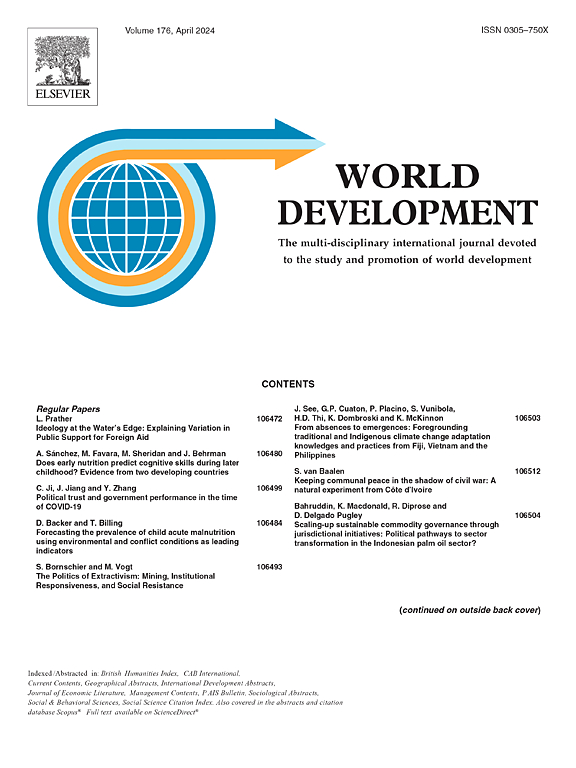The main global cultural differences today evolved from environment-related historical agricultural patterns
IF 5.4
1区 经济学
Q1 DEVELOPMENT STUDIES
引用次数: 0
Abstract
Decades of research have demonstrated that many cultural differences between modern nations are associated with a single dimension of culture, called “individualism-collectivism” (IDV-COLL) or various other terms (including Schwartz’s “embeddedness”), contrasting Northwestern Europe plus the English-speaking countries with countries at low geographic latitudes. IDV cultures are characterized by greater individual freedom (especially reproductive and religious), rule of law, and human rights than COLL ones. Despite a partial worldwide shift toward IDV, these country differences are relatively stable. Previous research explains them as a function of differences in wealth, climate, pathogen prevalence, Western Church policies, and more. We test a new theory: prevalent types of agriculture 100 years ago and earlier still explain IDV-COLL differences. We analyze two strongly correlated IDV-COLL versions, by Minkov-Kaasa and by Schwartz, as well as a new measure of objective COLL-IDV for 84 nations, consisting of household size, gender inequality, LGBT rights, and rule of law. We also use the Minkov-Kaasa IDV-COLL index for the 50 US states. For all national IDV-COLL/COLL-IDV measures, across the whole country sample, and across 35 culturally independent nations (thus avoiding autocorrelation), historically prevalent dairy farming is associated with IDV, whereas nomadic herding and shifting cultivation are associated with COLL. Across 48 US states, historically prevalent dairy farming predicts IDV, plantations predict COLL. Agriculture always produces the strongest direct effects. The effects of the other predictors are inconsistent, with the seeming exception of wealth. Yet, some environmental predictors have a distal effect on IDV-COLL, mostly through the mediation of agricultural types.
今天,主要的全球文化差异是从与环境有关的历史农业模式演变而来的
几十年的研究表明,现代国家之间的许多文化差异与文化的单一维度有关,称为“个人主义-集体主义”(IDV-COLL)或其他各种术语(包括施瓦茨的“嵌入性”),将西北欧和英语国家与地理纬度较低的国家进行对比。IDV文化的特点是比COLL文化有更大的个人自由(特别是生殖和宗教)、法治和人权。尽管世界范围内部分转向IDV,但这些国家之间的差异相对稳定。先前的研究将其解释为财富、气候、病原体流行程度、西方教会政策等方面差异的函数。我们测试了一个新的理论:100年前和更早的流行农业类型仍然可以解释IDV-COLL的差异。我们分析了Minkov-Kaasa和Schwartz的两个高度相关的idv - idl版本,以及84个国家的客观col - idv的新衡量标准,包括家庭规模、性别不平等、LGBT权利和法治。我们还对美国50个州使用了Minkov-Kaasa IDV-COLL指数。对于所有国家的IDV-COLL/COLL-IDV测量,在整个国家样本中,以及在35个文化独立的国家中(因此避免了自相关),历史上流行的奶牛养殖与IDV有关,而游牧和流动耕作与COLL有关。在美国48个州,历史上流行的奶牛养殖预测IDV,种植园预测COLL。农业总是产生最强烈的直接影响。除了财富之外,其他预测因素的影响并不一致。然而,一些环境预测因子对IDV-COLL有远端影响,主要是通过农业类型的中介。
本文章由计算机程序翻译,如有差异,请以英文原文为准。
求助全文
约1分钟内获得全文
求助全文
来源期刊

World Development
Multiple-
CiteScore
12.70
自引率
5.80%
发文量
320
期刊介绍:
World Development is a multi-disciplinary monthly journal of development studies. It seeks to explore ways of improving standards of living, and the human condition generally, by examining potential solutions to problems such as: poverty, unemployment, malnutrition, disease, lack of shelter, environmental degradation, inadequate scientific and technological resources, trade and payments imbalances, international debt, gender and ethnic discrimination, militarism and civil conflict, and lack of popular participation in economic and political life. Contributions offer constructive ideas and analysis, and highlight the lessons to be learned from the experiences of different nations, societies, and economies.
 求助内容:
求助内容: 应助结果提醒方式:
应助结果提醒方式:


